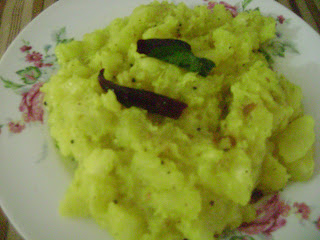We all take trouble to learn how to manage with the inadequate fork,
knife and spoon, to conform to the norm. The more adventurous, amongst us, even
venture to balance strands of those un-obliging & slithery noodles between
chopsticks, whilst carrying on a casual conversation, all the while wearing an
indifferent look...... been there.....done that, sort of...
Wonder though, how many of us Keralites,
know the art of serving & relishing a “SADYA”. It is not just about putting
it all there on the leaf.... and then polishing it off.
There apparently is a science as
to what is being served where... and when.
Timing the consumption of each
delicacy, some individually, and others in strict combinations, is another
matter that merits serious attention and rigorous discipline.
So here’s the when, how & whys of the Sadya delight .
History:
The grandiose saying “Naalum Kootty Unnuka” essentially implies that
the 4,(repeat four) accompaniments were
all that was required to complete a sumptuous sadya. Those were the modest Kaalan
& Olan and the unassuming Erissery & Pulissery.
With time, came the changes we now know.
Even where vegetables are concerned, yam(chena), ash gourd
(kumbalanga), colacassia (Chembu), red pumkin (Mathanga), snake gourd (Padavalam),
long beans (achinga),bitter gourd (pavakka), drumstick, raw banana (pacha kaya)
was all that we required to make a sadya. Now, the “English” vegetables have sneaked
their way in.
Serving:
First, let us learn to lay the leaf –tender
banana leaves are picked for this. The narrow end of the leaf should be on your
left.
Start serving the fried items
like chips, sharkaravaratti, pappadum & a small banana on the left hand
lower half of the leaf, closer to the diner.
Starting from the left on the
upper part of the leaf, place the pickles, Puli inji, Inji thayir, Pachadi, Kichadi,Kaalan,
Olan, Erissery, Aviyal, Mezhukkupuratti &Thoran in that order, from left to
right.(There are local variations like the Vada curry in South, Potato stew(prounced
ISHTU) in the Travancore region & Theeyal in North Kerala, which finds it
space between the erissery & aviyal.)
Rice is served on the lower half
of the leaf.
Ingestion
Now, the diner separates a little rice to be eaten with dhal, ghee
& a small pappadum crushed into it.
Next, is the Sambar. A little more rice can be taken aside for this
& a depression is made in the centre, so that the sambar doesn’t flow out
of the leaf. With this course, the thoran, erissery & the other dishes can be
tasted.
Munch on the chips & sharkaravaratti in between.
It’s the turn of the rasam now. Rasam is watery, so be careful when it’s
being served. (Folding the lower end of the leaf inward will help restrain its
flow.)
After this, the first prathaman is brought. Generally, a white & brown
prathaman will be on the list.
First the brown jaggery based one-either ada/wheat/banana/jackfruit payasam is served. To enjoy this, crush a pappadum & a small banana into the payasam, mix & enjoy. After this, you are expected to eat a little Olan (which is bland) to get rid
of the sweetness of the first payasam. A lick of the Puli inji also helps.
Next, the sugar based payasam is served. It can be anything from Ada,rice or vermicelli.
Now a days people prefer to drink the payasam from a cup, but then you
don’t get the full satisfaction of licking your hand from the base of your wrist
band to the very ends of your finger tip---in one loud, long, lingering
slurp! ...please do look around though....., lest you might offend those that
are less immune to culture shocks, the way we do.)
Burp ... (a little
... to express your satisfaction
... and not so much as to elicit disgust!)
To finish the Sadya, a little more rice is served to be eaten with Moru
(butter milk).
Finish whatever is left on the
leaf & fold the leaf inward, before you leave the table.
The Sadya is washed down with a glass of warm “ Karingali or jeeraka wellam” which aides digestion.
PS : Just in case, I’ve taken all the joy of polishing a sadya .... Just go ahead and
do what your heart tells you to do. I’ll still justify you... Thats what ONAM
is all about.
Eat while its harvest time !






